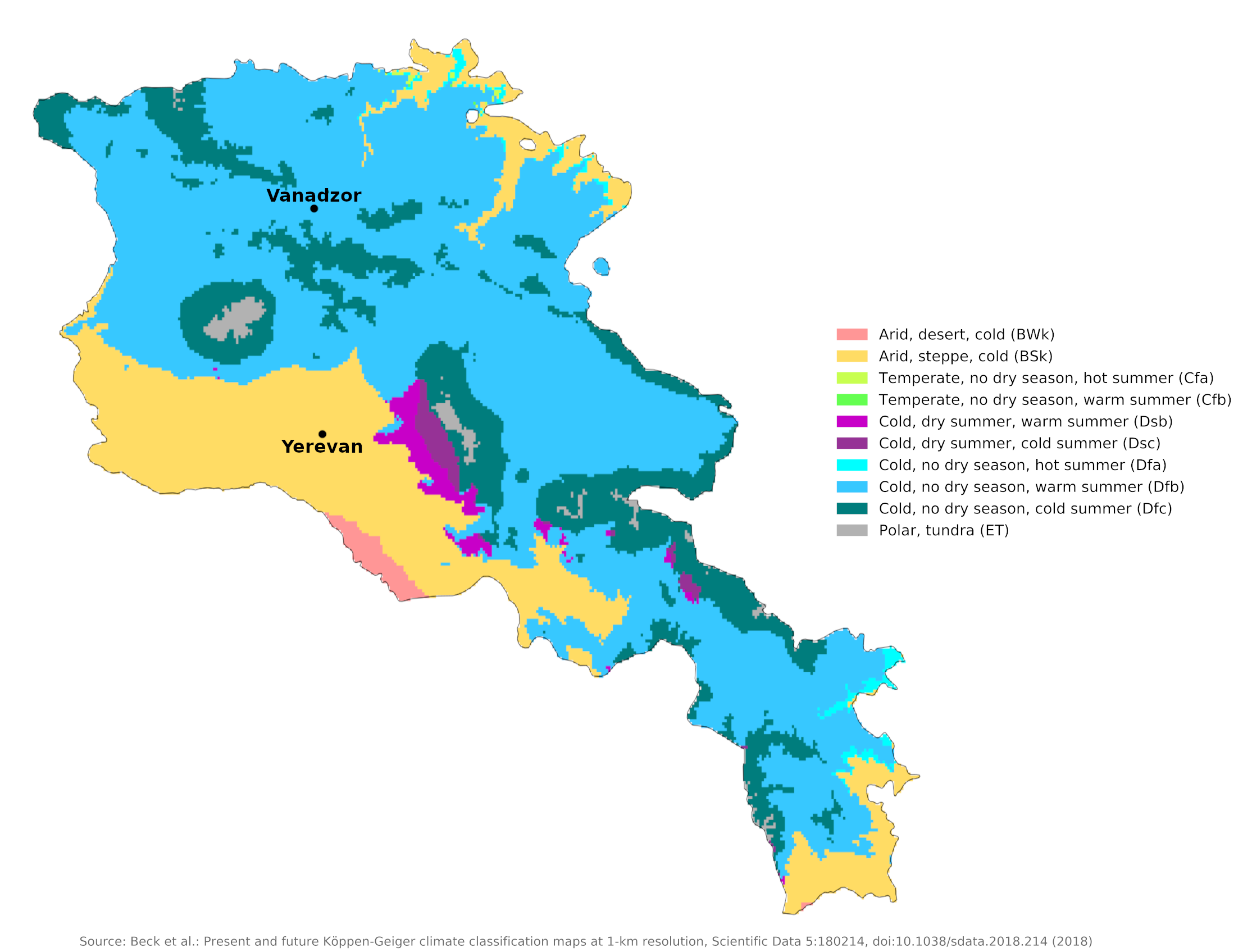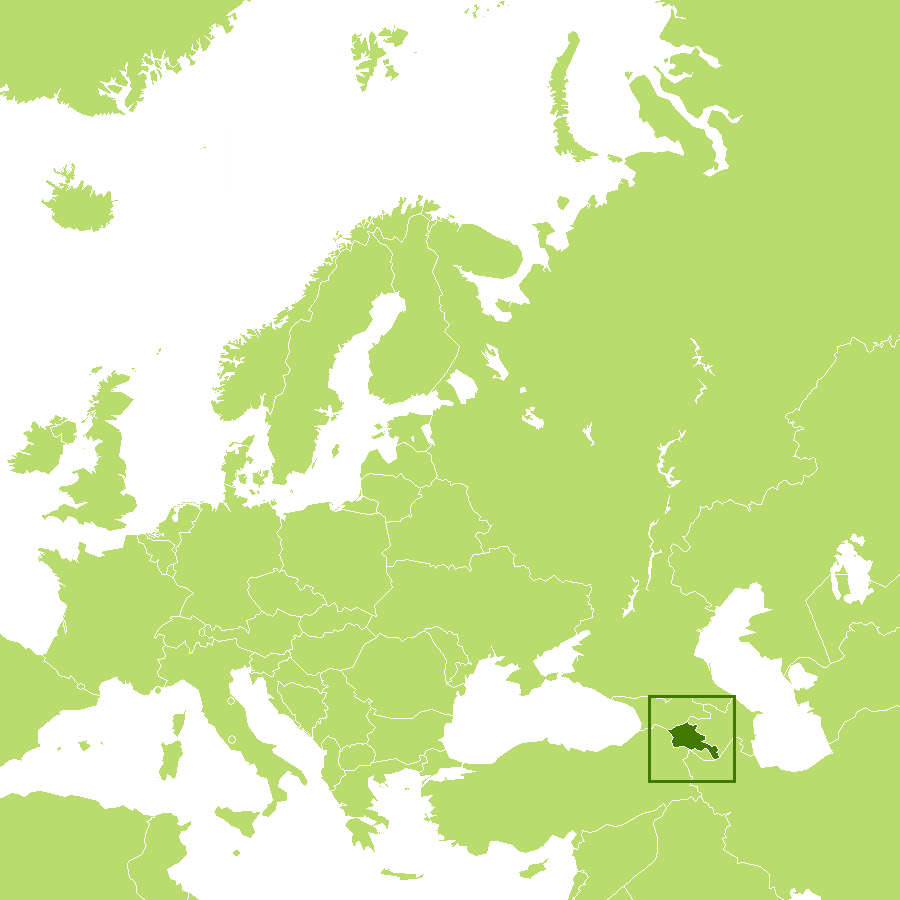The Climate of
Armenia
 Sculpture park in Yerevan
Sculpture park in Yerevan
Climate Map
 Climate map of the Armenia
Climate map of the Armenia
What is the climate of Armenia like?
Armenia is located in southeastern Europe/southwestern Asia. It shares boundaries with Georgia on the north, Azerbaijan on the east, Iran on the south, and Turkey on the west.
Armenia occupies a high, landlocked plateau south of the Caucasus. Here the Tigris and Euphrates rivers both have their sources. Temperatures in Armenia generally depend upon elevation. Mountains block the moderating climatic influences of the Mediterranean Sea and the Black Sea, creating wide seasonal variations. The climate is almost tropical in summer but nights are chilly. Winters are cold and snowy. The capital city, Yerevan, shows weather that is typical of the south; Vanadzor shows the conditions in the northern highlands.
Although Armenia lies not far from several seas, its high mountains block their effects and give it a continental highland climate. It has cold, dry winters and hot, dusty summers. Temperature and precipitation depend greatly on elevation, with colder and wetter seasons in the high north and northeast.
The widest variation in temperature between winter and summer occurs in the central Armenian Plateau. In the higher districts the winter is long and the cold severe; whilst the summer is short, dry and hot. In midwinter the mean temperature is 0°C (32°F); in midsummer the mean temperature is over 25°C (77°F). In the valley of the Aras, and in the western and southern districts, the climate is more moderate.
Overall, Armenia is a sunny country. Precipitation rates depend on altitude and location, but are lowest during summer and winter months. In the lower Aras River Valley, the average annual precipitation is 250 millimeters (10 inches). It can reach 800 millimeters (32 inches) in the mountains. Despite the severe winter in most parts, the fertility of the plateau's volcanic soil made Armenia one of the world's earliest places of agricultural activity.| Climate data for Yerevan (1991–2020) | |||||||||||||
|---|---|---|---|---|---|---|---|---|---|---|---|---|---|
| Month | Jan | Feb | Mar | Apr | May | Jun | Jul | Aug | Sep | Oct | Nov | Dec | Year |
| Average high °C (°F) | 1.7 (35.1) | 6.3 (43.3) | 13.7 (56.7) | 19.8 (67.6) | 25.1 (77.2) | 30.9 (87.6) | 34.5 (94.1) | 34.4 (93.9) | 29.2 (84.6) | 21.6 (70.9) | 12.8 (55.0) | 4.2 (39.6) | 19.5 (67.1) |
| Daily mean °C (°F) | −3.5 (25.7) | 0.0 (32.0) | 7.0 (44.6) | 12.9 (55.2) | 17.7 (63.9) | 23.1 (73.6) | 26.8 (80.2) | 26.7 (80.1) | 21.4 (70.5) | 14.0 (57.2) | 5.8 (42.4) | −0.8 (30.6) | 12.6 (54.7) |
| Average low °C (°F) | −7.8 (18.0) | −5.4 (22.3) | 0.9 (33.6) | 6.4 (43.5) | 10.8 (51.4) | 15.1 (59.2) | 19.1 (66.4) | 18.9 (66.0) | 13.2 (55.8) | 7.1 (44.8) | 0.1 (32.2) | −4.9 (23.2) | 6.1 (43.0) |
| Average precipitation mm (inches) | 21 (0.8) | 21 (0.8) | 60 (2.4) | 56 (2.2) | 47 (1.9) | 24 (0.9) | 17 (0.7) | 10 (0.4) | 10 (0.4) | 51 (2.0) | 25 (1.0) | 21 (0.8) | 363 (14.3) |
| Source: www.pogodaiklimat.ru | |||||||||||||
| Climate data for Vanadzor | |||||||||||||
|---|---|---|---|---|---|---|---|---|---|---|---|---|---|
| Month | Jan | Feb | Mar | Apr | May | Jun | Jul | Aug | Sep | Oct | Nov | Dec | Year |
| Average high °C (°F) | 1.2 (34.2) | 2.3 (36.1) | 6.9 (44.4) | 13.3 (55.9) | 18.6 (65.5) | 22.6 (72.7) | 25.7 (78.3) | 25.6 (78.1) | 22.0 (71.6) | 16.3 (61.3) | 9.1 (48.4) | 3.3 (37.9) | 13.9 (57.0) |
| Daily mean °C (°F) | −3.7 (25.3) | −2.7 (27.1) | 1.8 (35.2) | 7.4 (45.3) | 12.4 (54.3) | 16.0 (60.8) | 19.0 (66.2) | 18.9 (66.0) | 14.9 (58.8) | 9.8 (49.6) | 3.9 (39.0) | −1.1 (30.0) | 8.1 (46.5) |
| Average low °C (°F) | −8.5 (16.7) | −7.6 (18.3) | −3.3 (26.1) | 1.6 (34.9) | 6.3 (43.3) | 9.5 (49.1) | 12.3 (54.1) | 12.2 (54.0) | 7.8 (46.0) | 3.3 (37.9) | −1.2 (29.8) | −5.5 (22.1) | 2.2 (36.0) |
| Average precipitation mm (inches) | 20 (0.8) | 26 (1.0) | 36 (1.4) | 57 (2.2) | 94 (3.7) | 83 (3.3) | 51 (2.0) | 42 (1.7) | 33 (1.3) | 41 (1.6) | 32 (1.3) | 19 (0.7) | 534 (21) |
| Source: Climate-Data.org | |||||||||||||
References
- E. A. Pearce, Charles Gordon Smith, (1990) The Hutchinson World Weather Guide, John Murray Press. ISBN 1859863426
- Timothy L. Gall, (ed.), (2003), Worldmark Encyclopedia of the Nations, Eleventh Edition, Thomson Gale
- Federal Research Division, Library of Congress, (1995), Armenia, Azerbaijan, and Georgia: country studies. Claitor's Pub. Division. ISBN 0844408484
- Hugh Chisholm, (ed.), (1911), Encyclopædia Britannica, Eleventh edition, Cambridge University Press
The Climate of
Armenia

In summary:
Armenia’s climate ranges from subtropical to alpine-like in the mountains. The mean temperature in midsummer is 25°C (77°F). In midwinter, the mean temperature is 0°C (32°F ). Rainfall is infrequent. The capital city receives 360 mm (14 in) of rain annually, though more rainfall occurs in the mountains.